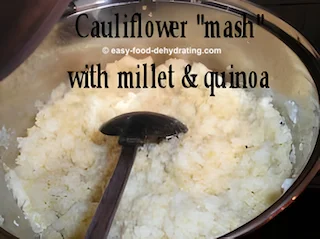What We Mean by “Dehydrate”
Here at Easy Food Dehydrating, “dehydrate” always means using an electric food dehydrator — the easy, reliable way to dry food at home.
- Home
- Dehydrating Vegetables: Step-by-Step Guides by Type
- How to Dehydrate Cauliflower
How to Dehydrate Cauliflower:
Easy Storage Tips & Recipes

Whether you’re prepping for long-term storage, making low-carb meals, or simply cutting food waste, knowing how to dehydrate cauliflower is a game-changer. Drying cauliflower locks in nutrition and flavor while freeing up precious freezer space.
✅ Quick Answer: How do you dehydrate cauliflower?
Cut cauliflower into florets, blanch briefly in boiling water, then arrange on dehydrator trays. Dry at 125–135°F for 6–14 hours until brittle. Store in airtight containers. Use for soups, mash, or grind into cauliflower rice or powder.
This guide walks you through the entire process step-by-step - from cutting and blanching to dehydrating, storing, and using it in recipes like cauliflower soup or mash. You’ll also find tips for turning it into rice or powder for extra versatility.
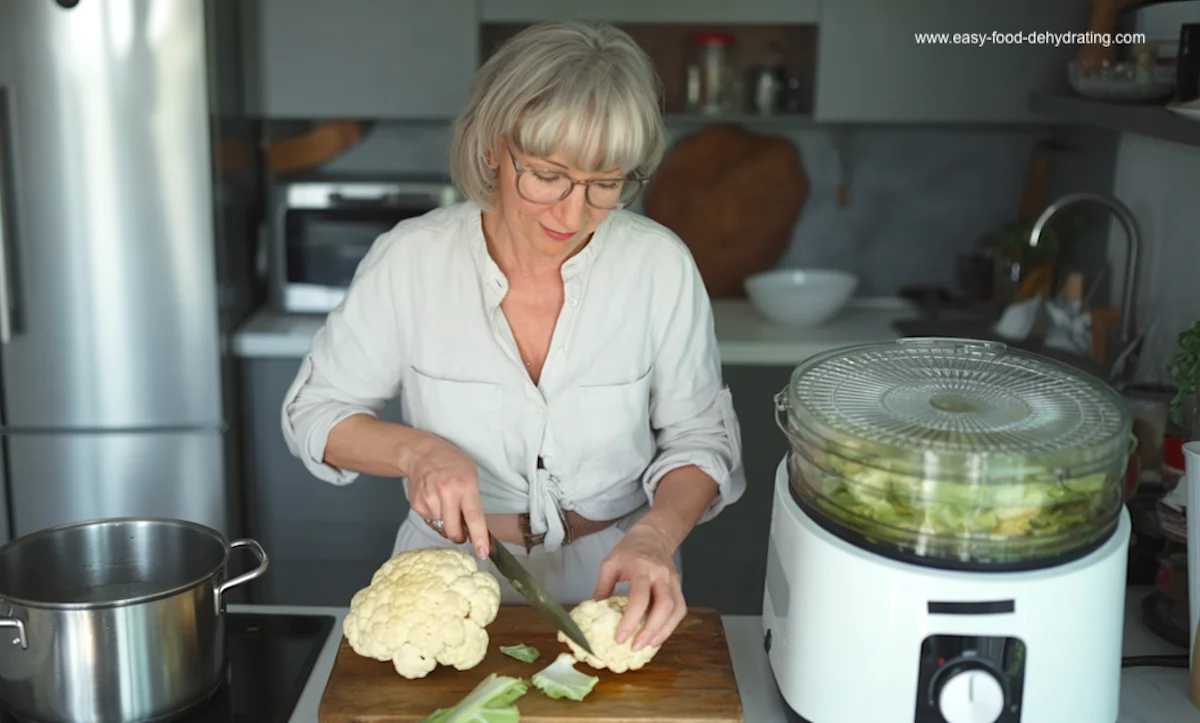
It's so easy to dry cauliflower when it's in season so you can make delicious Cauliflower Soup and Cauliflower Mash any time of the year.
Scroll down to the page bottom where you'll find clickable photos for both recipes!
Also, don't miss the FAQs as you'll learn how to make Cauliflower Rice and Cauliflower Powder.
Why Dehydrated Cauliflower Makes the Best Mashed Potato Swap
Add millet and quinoa to the cauliflower mash for a significant source of protein. Kids really like this cauliflower mash, as it compares favorably to 'mashed potatoes'.
Cauliflower florets add a great crunch to add texture to summer salads too!

Cauliflower Nutrition: Vitamins, Minerals & Health Benefits
VITAMINS: Vitamins A and C, and Choline, followed by Pantothenic Acid, Vitamin B6, Niacin, and Riboflavin, with trace amounts of Vitamin E, and Vitamin K.
MINERALS: Potassium, followed by Phosphorus, Calcium, and Magnesium. There are trace amounts of Selenium, Iron, Zinc, Manganese, and Fluoride.
Cauliflower contains Omega-3 and Omega-6 fatty acids.
Step-by-Step: How to Dehydrate Cauliflower at Home
Are you ready to get busy dehydrating cauliflower? Here's how:
If using frozen cauliflower, ignore steps 1 and 2.
- Wash and slice fresh cauliflower into 1/2" thick pieces.
- Blanch the cauliflower in a small amount of boiling water for a few minutes, in batches.
- Arrange on your food dehydrator trays, making sure the cauliflower pieces don't touch, for good air circulation.
- Turn on your food dehydrator and set the temperature between 125°F and 135°F(or per your food dehydrator's instructions).
💡 Tip: Outside the U.S.? Most dehydrating temps here are listed in Fahrenheit - use our quick converter to see the Celsius equivalent for your machine.
- Dehydrated cauliflower will be brittle when fully dried.
- Drying time: between 6-14 hours.
- Please remember to rotate your trays for even drying.
Best Knife for Effortless Cauliflower Chopping
Begin by Using a Good Sharp Knife by Cutluxe!
Check out this great chef's knife with a full tang that means the handle and blade "are one" so they can't come apart when we're slicin' and a dicin'.
I know these Cutluxe Chef knives may be a little expensive, but they do last pretty much a lifetime when you maintain their cutting edges.
As an Amazon Associate, I earn from qualifying purchases — this does not affect the price you pay. Read full disclosure.
Mandoline Magic: Get Even Cauliflower Slices Every Time
Or... treat yourself to one of these ab fab slicer/mandolines...
SUPMAKIN Slicer + Dicer Mandoline ~ OnceForAll Brand
French fry cutter, vegetable chopper, vegetable slicer cutter, potato slicer, chopper for kitchen meal prep.
See my review of this multi-function mandoline that I just couldn't resist getting!
NOTE:
You MAY have to slice the larger cauliflower pieces in half so
that the cauliflower will fit better between the food dehydrator trays.
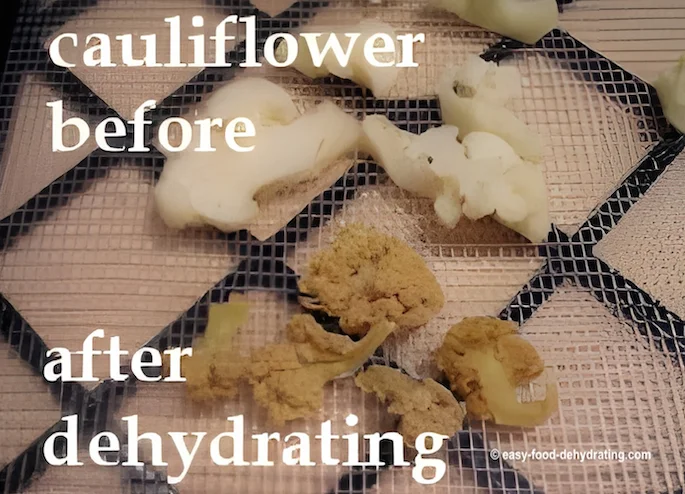
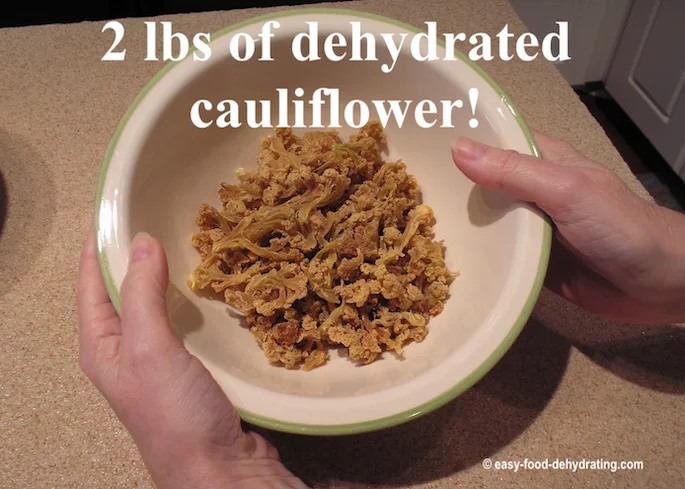
In the photo above the dehydrated cauliflower looks rather brown, but don't
worry about that as it turns back to white when it's re-hydrated! Honest :-)
Quick Trick: How to Thaw Frozen Cauliflower for Dehydrating
Let the cauliflower thaw out (in its bag, unopened) in your kitchen sink in a bowl of tepid water if you're short on time. Otherwise, let the cauliflower bag thaw out for around an hour in your kitchen sink, unopened, then chop and put on the trays.
If thawing the frozen cauliflower by the water-in-the-bowl method, keep changing out the tepid water in the bowl until the cauliflower has thawed sufficiently for you to be able to cut (feel the pieces while they're still in the bag until they're soft enough).
This
will probably take about 10 minutes. Keep on reading for how to dehydrate cauliflower on a dehydrator.
Two Recipes You’ll Love With Dehydrated Cauliflower
Click the images to be taken to their recipes, or use these links: Cauliflower Soup and Cauliflower Mash.
Why Cauliflower Comes in Purple, Green, and Orange Colors
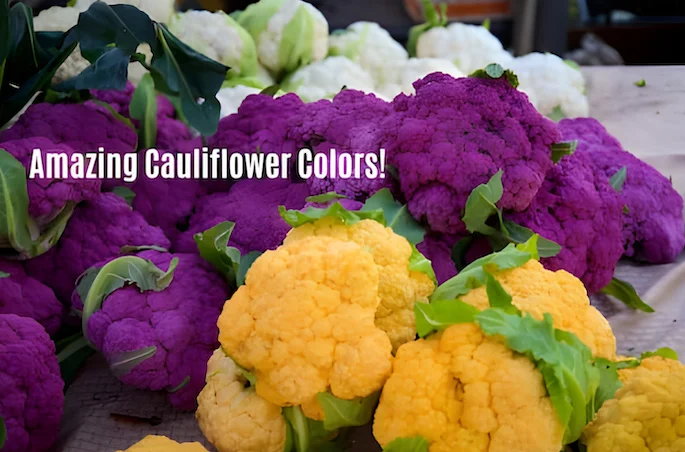
dCauliflower comes in a rainbow of colors, thanks to natural plant pigments.
Anthocyanins create the purple and blue varieties (the same compounds found in blueberries and eggplant), while carotenoids give orange cauliflower its sunny hue, just like in carrots and sweet potatoes.
The classic white cauliflower we all know is simply the absence of those pigments.
Cauliflower Dehydrating: Your Top Questions, Answered
How do I store dehydrated cauliflower for the longest shelf life?
How do I store dehydrated cauliflower for the longest shelf life?
Store fully dried cauliflower in airtight containers like Mason jars or vacuum-sealed bags. Keep in a cool, dark place. For even longer storage, add an oxygen absorber.
How do I rehydrate cauliflower before cooking?
How do I rehydrate cauliflower before cooking?
Cover dried cauliflower with boiling water (2 parts water to 1 part cauliflower). Let sit 5–10 minutes, then use in soups, casseroles, or mash.
Can I dehydrate cauliflower without blanching?
Can I dehydrate cauliflower without blanching?
Yes, but blanching helps preserve color, texture, and nutrients. Without blanching, cauliflower may turn darker and lose some crunch.
What’s the best way to make cauliflower rice from dehydrated cauliflower?
What’s the best way to make cauliflower rice from dehydrated cauliflower?
Pulse dried florets in a food processor until rice-like. Rehydrate with hot water for 5–10 minutes, then cook as you would fresh cauliflower rice.
How long does dehydrated cauliflower last?
How long does dehydrated cauliflower last?
When stored properly, dehydrated cauliflower lasts 12–18 months. If vacuum-sealed and kept with oxygen absorbers, it can last even longer.
Can you make cauliflower powder from dehydrated cauliflower?
Can you make cauliflower powder from dehydrated cauliflower?
Yes! Dry cauliflower florets or rice until brittle, then blend into a fine powder. Store in an airtight jar or vacuum-sealed bag. Add a spoonful to soups, stews, smoothies, or homemade breading for extra nutrition.
I hope this guide has made dehydrating cauliflower feel simple and rewarding! From soups to mash, and even handy cauliflower powder, it’s a versatile staple to keep on hand.
And if you’d like more inspiration, be sure to grab the free 5 Dried Food Recipes You'll Actually Love PDF below — featuring my favorites like carrot soup, minestrone, split pea soup, spicy beef jerky, and banana cinnamon rolls. They’ll show you just how tasty dehydrated meals can be.
Get 5 Dried Food Recipes You'll Actually Love
Here's where you can get your copy of our all new
5 Dried Food Recipes (That Actually Taste Great)
They're my all-time favorite easy dried food meals!
Get it here right now.
For Free!
Before You Go...
If you enjoyed this page, tap the ❤️ in the lower right-hand corner.
It saves this page to your Grow bookmarks so you can find it again later.
You’ll also see quick share buttons to copy the link, post to Facebook,
or save it straight to Pinterest.



